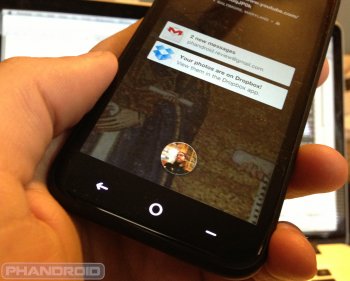
HTC First Review [VIDEO]
After years of rumors, talk of the “Facebook Phone” has finally paid off in the form of Facebook Home and the first device to run the social network’s Android launcher, the HTC First. An AT&T exclusive, the First combines the expected build quality of HTC with a simple user experience designed to put interactions with friends front-and-center. But is the mid-range handset worth its $99 price tag? Or are you better off running Facebook Home on another Android device, if at all? Check out our review to find out.
Hardware
Upon initial inspection, the HTC First is a rather unassuming smartphone. The look is that of the basic “rounded rectangle” and uses HTC’s familiar unibody design. The device is seamless for the most part with no removable back plate. The exterior gets a nice soft-touch finish, and the phone measures in at 0.35-inches thick and remains light at just 4.37 ounces.
Inside is a dual-core Qualcomm 8930AA processor clocked at 1.4GHz, 1GB RAM, and 16GB of internal storage. The First sports a 5MP rear camera and 1.6MP front-facing camera. A 2000mAh cell provides the necessary power and offers decent battery life overall. In terms of connectivity, the handset is compatible with AT&T’s 4G LTE network as well as HSPA+ on top of WiFi, Bluetooth 4.0, and NFC
The First might not be a powerhouse flagship, and it certainly lacks any innovative hardware features, but considering what the handset is accomplishing that doesn’t detract much from the overall experience. The real selling point of the phone is its Facebook Home interface, and the simple, no frills approach means you get an uninhibited look into your social life, framed by the window of a 4.3-inch 720p display. This may have been intentional, or perhaps HTC was diverting most of their attention to the One, but those buying the First are likely doing so more for the experience and less for the hardware, which ends up as a serviceable mid-range Android handset.
Software
The software is the real meat of the HTC First, bringing Facebook Home to an Android handset for the first time. Facebook Home is a lockscreen launcher that sits above a build of Android 4.1, providing instant access to your Facebook feed in the form of full-screen images and cycled status updates. Interacting with photos or comments is as easy as tapping the screen to “like.”
Facebook Home does offer a few novel ideas that are actually executed pretty well. Messaging is a big focus with the First and Facebook Home, and new pop-out Chat Heads make it easy to keep conversations going overtop of any application. Swiping gestures make it easy to interact with messages and content, a favorite being the ability to swipe items down to remove them from the screen. The folks at Facebook have provided quick access to all the standards, including notifications, the applications drawer, and the ability to share a photo or post a status.
While Home is great for what it is designed for, as a Smartphone “operating system” its functions feel rather limited. It’s a good thing the interface can be easily disabled, making the First a stock Jelly Bean device in an HTC package — something quite a few fans of the manufacturer have been asking for. We get the feeling that most that switch to the Jelly Bean UI will simply leave it that way. Otherwise, Facebook Home provides a rather beautiful view into your social world, though it comes at the expense of making the handset feel a little less robust compared to other Android phones.
Camera
As expected, the First features a camera typical to what is expected from HTC. The sensor is only rated at 5MP, and we’re not getting the same UltraPixel lens found in the HTC One, but even still the camera can capture respectable photos and video. In the right hands, the First is perfectly capable in most situations.
The First performs decently in low-light situations and does an average job in the color reproduction department. Most of the shots captured here are from a cloudy day, so the slight dullness can be attributed more to lighting than actual camera performance.
Ultimately, the First’s camera is the lens through which the user’s world will be viewed, plugged directly into Facebook. In this sense, the phone should do fine for capturing the moments you want to share with friends or slap an Instagram filter on top of, but given Facebook Home’s emphasis on images as part of its user interface it would have been nice to see a greater focus on the camera here.
Conclusion
Facebook Home is one of the most innovative new approaches to the Android UI that we have seen in quite some time. It rides the line between its own mobile OS and simply an extension of the Jelly Bean build it sits on top of. The First is built to be the perfect phone to show off Facebook’s vision, and it does the job just fine. However, the First and Facebook Home won’t be for everyone. Those seeking a top-tier device from HTC are better off looking at the One, but the First is great for its target audience. If you can’t spend a minute disconnected from your social life, the First and Facebook Home might just be the phone for you.